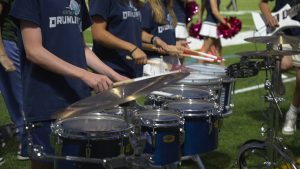Running the risk of injury
November 3, 2017
Sports are dangerous, and people get hurt. That’s just the unfortunate reality of competitive physical activity.
When we picture injuries, we think of professional athletes and how their injuries impact a team’s success. That’s why when you hear the name Derek Rose or more recently Aaron Rodgers, the first thought that comes to mind is their injuries.
What we don’t really consider is the role that an injury plays on that individual beyond physical pain. My experiences running cross country and track have shown me the mentally taxing effects of injuries.
I know that high school sports aren’t on the same level as collegiate or professional sports, but that makes the few injuries that occur even more infuriating considering they’re in a smaller, more contained setting.
Before running on a team, I would’ve never considered running as such an injury-prone activity. As much as I love to run – I ran down hallways as a child imagining I was The Flash – I’m just not equipped to handle the sport, leading me into several injuries that repeatedly prevented me from running with my teammates.
What really hurts isn’t the injury itself, but the feeling of being powerless. I don’t know how Derek Rose felt when he couldn’t play basketball, but I know how grumpy I became whenever I was injured.
The worst came during my junior year track season when I felt sharp pain in my ankle. Even though it hurt to walk, I initially ran through it since I had already faced so many injuries and wanted to help the team.
At that point, I was willing to endure any physical pain to avoid the disappointment of being injured yet again.
I ran well enough, but the injury worsened. Every step was like a saw gnawing at my right leg. The doctor diagnosed it.
A stress fracture in the distal fibula by the ankle, and over three months in a boot to recover.
There were times in this past summer of recuperation that were agonizing, especially with how slow the time was passing. Instead of running down the halls back and forth in excitement, I paced down them out of frustration.
I want to stress – no pun intended – that I’m not looking for pity. In fact, I’d like to bring awareness to how challenges like injuries help us grow.
I found solace for my feeling of imprisonment by spending time in the company of others. My coworkers and the kids I talked with as a camp counselor redeemed my summer.
And being with the team kept me sane too. I adopted a new philosophy, focusing on what was within my control. I cross-trained while the team practiced to keep myself busy, and I made an active effort to talk with teammates, helping out wherever I could.
And if that means going to every meet and cheering until my lungs burn to motivate a close friend, then so be it.
The training that the team put in this season to get to state tomorrow has inspired me to strive to be better, not necessarily in terms of running, but to keep moving forward past struggles.
I suppose that the injury has had that positive influence on me. Lobbing my right leg around for a few months made my outlook much more positive, making me realize that with a modest approach, not too hopeful nor too self-deprecating, my problems have much less of an impact on me.
Even now, when I struggle with shin splints and recurring uncertainty about my ankle, I remain optimistic, keeping in mind that whether or not I run isn’t going to change the fabric of my existence, but my outlook will.
The unseen internal struggles ultimately shape the external.
So when your favorite star athlete inevitably goes down to injury, consider the sport of shaping their outlook they’re trying to play.











































